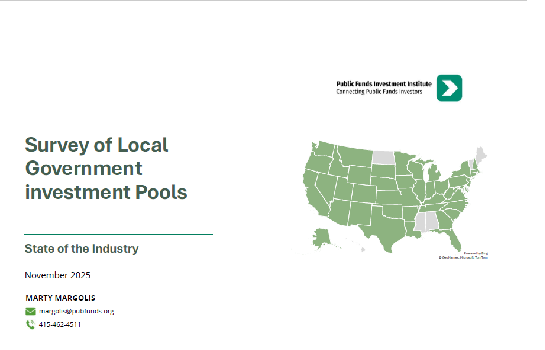Research and Analysis
2024 LGIP Survey: LGIPs Hold Nearly $1 Trillion of Public Funds
November 12, 2025
Marty Margolis
 Our annual survey of local government investment pools is out.
Our annual survey of local government investment pools is out.
This year we expanded our survey to include local sponsored LGIPs. In total we identified 161 portfolios. They operate in all but seven states.
The survey is the only comprehensive look at the LGIP industry which invests assets for thousands of public units across the country.
Here are some highlights:
- LGIPs held $931 billion in state and local government assets at the end of last year.
- State sponsored programs dominate the industry with assets totaling $691 billion in 32 states. Average portfolio size was $14.7 billion in 47 portfolios.
- Local sponsored LGIPs are smaller, with average size of $2.1 billion, but there are many more of them—114 portfolios in our survey.
- After several years of rapid growth, the path leveled in 2024, with assets of state-sponsored programs growing by 3% over 2023. (We did not survey local sponsored programs in2023.)
- Most state sponsored portfolio assets are managed internally, but outside mangers are responsible for nearly 30% of assets. All local sponsored LGIPs have external managers.
- Stable value portfolios constituted more than 99% of LGIP assets. These seek to provide a constant net asset value just as money market mutual funds do. Some LGIPs also offer longer duration investment portfolios. While there were 28 of these offered, their assets totaled barely $15 billion.
- LGIPs compete with money market funds whose assets totaled more than $7 trillion at the end of last year. LGIPs are not subject to most Securities and Exchange Commission rules, and they operate with greater flexibility than registered funds.
- State sponsored LGIPS operate at low expense ratios. They averaged 5.8 basis points last year, much lower than the average for institutional money market funds.
- Local sponsored LGIP expense ratios were appreciably higher, averaging 18.2 basis points.
- Disclosure and transparency among LGIPs vary from some whose disclosure follows SEC requirements for money market funds to others that provide little public disclosure of their shareholder and investment activities.
The survey results provide state treasurers and trustees of LGIPs with details on how programs operate across the nation. They also provide investors with key information to help them evaluate and monitor LGIPs that they invest in.
For details Download the LGIP Survey Report.


